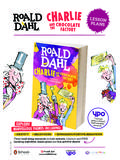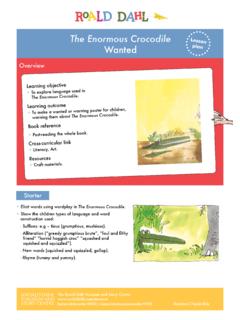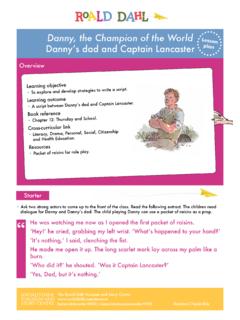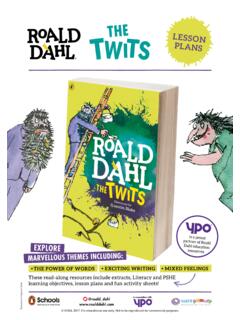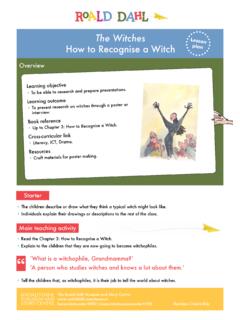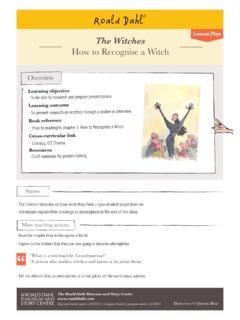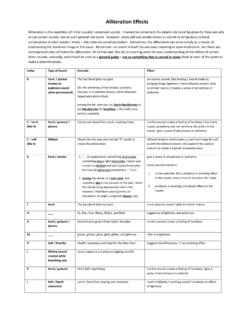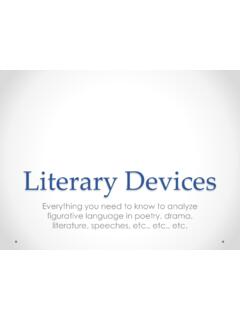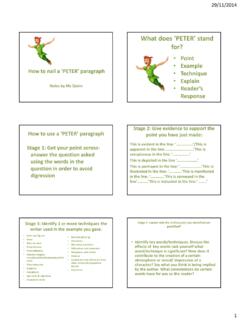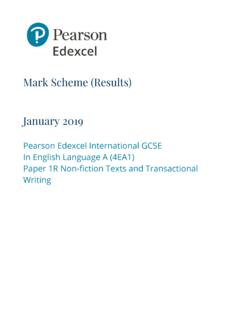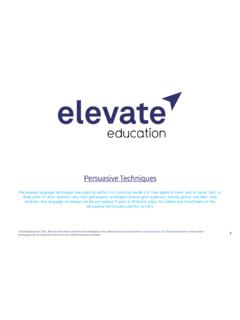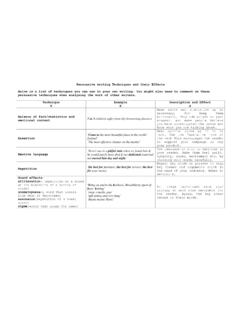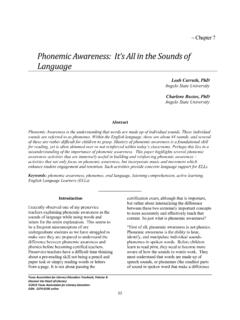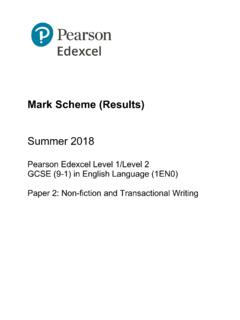Transcription of LESSON PLANS - Roald Dahl
1 EXCITING WRITINGT hese read-along resources include extracts, Literacy and PSHE learning objectives, LESSON PLANS and fun activity sheets!Illustrations Quentin Blake THE POWER OF WORDS MIXED FEELINGSLESSON PLANSMARVELLOUS THEMES INCLUDING:EXPLOREis a proud partner of Roald Dahl education @roald_dahlIn association with RDNL 2017. For educational use only. Not to be reproduced for commercial Quentin @roald_dahlIn association with2 CONTENTSLESSON plan 1: BOOK THEME: The power of wordsLITERACY OBJECTIVE: Identifying alliteration , onomatopoeia and rhyming patterns in Roald Dahl s poetry and exploring their effect on the reader. Writing an original poem, using Roald Dahl s work as a OBJECTIVE: Participating constructively in discussions by making appropriate comments, taking turns and listening to USED: from The Cook up . LESSON plan 2:BOOK THEME: Masters of InventionLITERACY OBJECTIVE: Using alliteration and adverbs effectively.
2 Using persuasive OBJECTIVE: Understanding that commonly available substances and drugs can damage USED: from George Begins to Make the Medicine . LESSON plan 3:BOOK THEME: Exciting writingLITERACY OBJECTIVE: Identifying how Roald Dahl uses language, punctuation and text styles to generate excitement. Writing similes using Roald Dahl s work as a stimulus. Understanding how dramatic techniques bring stories to USED: from Grandma Gets the Medicine . LESSON plan 4:BOOK THEME: RevengeneLITERACY OBJECTIVE: Drawing inferences and justifying them with evidence from the a deep understanding of the character of Grandma and creating an original character profile based upon George s OBJECTIVE: Understanding that revenge has a negative impact on both the perpetrator and the USED: from Grandma LESSON plan 5:BOOK THEME: Sensational storiesLITERACY OBJECTIVE: Identifying and using exciting verbs, adverbs and adjectives.
3 Planning a piece of writing based upon the vocabulary and structure of George s Marvellous OBJECTIVE: Providing, receiving and responding to constructive feedback, recognising and learning from others USED: from Grandma . LESSON plan 6:BOOK THEME: Mixed feelingsLITERACY OBJECTIVE: Drawing inferences about characters feelings, justifying their inferences with evidence from the OBJECTIVE: Understanding what is meant by having conflicting (or mixed ) emotionsIdentifying when to heed emotions and when to try to overcome USED: from Grandma . GEORGE S MARVELLOUS MEDICINE POSTER ACTIVITY SHEETS X 3 INVENTOR S LOG THINGS YOU MAY NEED FOR THESE LESSON PLANSI llustrations Quentin @roald_dahlIn association with3 PREPARATION:Each child will need a copy of both extracts and of each of the three resources. For activity two, you will need to provide each child with a copy of a common tongue twister and each group with a saucepan, a wooden spoon and a selection of revolting ingredients - a smelly sock, a rubber snake, a jar of slime (there are plenty of recipes available on the internet), ACTIVITY: Read extract one.
4 Ask children what George is putting into his medicine. Which adjectives has Roald Dahl used to describe some of the ingredients? What effect do these adjectives have on us as readers? MAIN TASK: WONDROUS WORDSD ivide children into groups. Set up a carousel of activities in which children investigate how Roald Dahl skilfully manipulates words to achieve extraordinary effects. Activity one: Children read extract one independently, then invite one or two to read it aloud. Which words rhyme? Is there any rhyming pattern to the poem? Prompt them to notice that it s written in rhyming couplets. Why do children think Dahl used rhyming couplets? What effect does this have on the reader? Children should use RESOURCE1: REVOLTING RHYMES to generate new rhyming words for Roald Dahl s ..BOOK THEMES: The power of wordsLESSON OBJECTIVES: Identifying alliteration , onomatopoeia and rhyming patterns in Roald Dahl s poetry and exploring their effect on the reader Writing an original poem, using Roald Dahl s work as a model Participating constructively in discussions by making appropriate comments, taking turns and listening to othersTHINGS YOU MAY NEED FOR THIS LESSON :Poetry writing resources and rhyme games.
5 See page 47 LESSON plan 1 Illustrations Quentin @roald_dahlIn association with4 Activity two: Give children copies of extract one along with some well-known tongue twisters like She sells sea shells on the sea shore , Red lorry, yellow lorry, red lorry, yellow lorry and Peter Piper picked a peck of pickled pepper . Why are these called tongue-twisters? How does the extract compare with the tongue-twisters? Clarify that when words close together start with the same letter or sound it s called alliteration . Why do children think that Roald Dahl used alliteration ? Set out a revolting selection of ingredients a smelly sock, a rubber snake, pretend worms, a tray of mud, a jar of slime, a revolting picture of a slug, something hairy and so on together with a saucepan and a spoon. Each child chooses something to drop into the saucepan.
6 As they stir they say the name of their ingredient together with an alliterative adjective: mouldy mud . Extend by asking them for two alliterative adjectives, for example: slippery, sludgy slime . Activity three: Introduce the term onomatopoeia if children don t know it. Ask children to define the word onomatopoeia . Why do they think Roald Dahl has used onomatopoeia in his poem? Ask children to highlight all the noisy (onomatopoeic) words in extract one, then to write down as many noisy words as they can think of to match the pictures on RESOURCE 2: SOUND SCORCERY. DEVELOPING THE ACTIVITY: PERILOUS POTIONSRead extract two, William Shakespeare s Double, double toil and trouble from Macbeth. Examine the poem together so that children understand the context if they are unfamiliar with the play. Discuss which ingredients the witches have thrown into their cauldron, deciphering tricky language.
7 Children should compare and contrast this poem to Roald Dahl s. In order to do this, divide them into small groups and give each group a copy of extracts one and two. Ask each group to compare a different literary feature: alliteration , onomatopoeia, rhyming pattern, use of repetition and the subject matter itself. After a few minutes ask children to feed back their discoveries to the class. Do they think that Roald Dahl was influenced by William Shakespeare? Why or why not?Invite children to write their own magic medicine poem on RESOURCE 3: MY PERILOUS POTION; they should use what they ve written on resources one and two to help them. EXTENSION:You may also like to introduce a DT/ Computing element, asking children to design covers for a class magic medicine recipe book. Start by analysing the features of ordinary cookbook covers. Discuss what will be the same and what will need to be adapted given that theirs is an enchanted recipe book.
8 LESSON plan 1 PLENARY:Divide children into small groups and ask them to choose one poem from the group to perform. Give them time to practise performing their own poems, perhaps playing a YouTube dramatization of Double, double toil and trouble as take turns to perform their poems. After each performance ask the audience to comment positively upon what they have seen, encouraging them to talk about what they enjoyed using terms such as alliteration , onomatopoeia , rhyme , repetition and adjectives , as well as ways in which the actors engaged with the audience, bringing the poem to Quentin @roald_dahlIn association with5 EXTRACT ONE from The Cook-up ( ) Fiery broth and witch s brewFoamy froth and riches blueFume and spume and spoondrift sprayFizzle swizzle shout hoorayWatch it sloshing, swashing, sploshingHear it hissing, squishing, spissingGrandma better start to pray.
9 EXTRACT FROMI llustrations Quentin @roald_dahlIn association with6 EXTRACT TWO Double, double toil and trouble, Macbeth, William ShakespeareDouble, double toil and trouble; Fire burn and caldron bubble. Fillet of a fenny snake, In the caldron boil and bake; Eye of newt and toe of frog, Wool of bat and tongue of dog, Adder s fork and blind-worm s sting, Lizard s leg and howlet s wing, For a charm of powerful trouble, Like a hell-broth boil and bubble. Double, double toil and trouble; Fire burn and caldron bubble. Cool it with a baboon s blood, Then the charm is firm and FROMI llustrations Quentin @roald_dahlIn association with7 FEARGOESSMELLSEEWORMSMOKEKNEWSTRONGR oald Dahl was the ruler of rhyme. Has he met his match in you today? Here s your challenge: follow the smoky lines and rhyme the words below. If you can think of even more rhymes, then take a bow and accept your crown as the new king or queen!
10 REVOLTINGRHYMESI llustrations Quentin @roald_dahlIn association with8 SOUNDSCORCERYG eorge s bubbling brew pops, fizzes and crackles as it boils. How good are you at generating loud language (also known as onomatopoeia. Try saying it: on-oh-mat-oh-pea-yah)? Let s see what you can do!Illustrations Quentin @roald_dahlIn association with9MY PERILOUS POTIONS aucepans at the ready, it s time to make your own magic medicine. First you need to decide what special power your magic medicine will have. Then you need a revolting recipe. s perilous potion for potion s special powersINGREDIENTS:A generous helping of rhyming couplets For example: Throw in a wiggly, squiggly worm. That should make your tummy squirm . Resource 1 should give you plenty of ideas if you are stuck.
